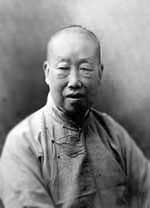Wu Changshuo

| Wu Changshuo | |
|---|---|
 | |
| Traditional Chinese | 吳昌碩 |
| Simplified Chinese | 吴昌硕 |
| Hanyu Pinyin | Wú Chāngshí |
Template:Chinese name Wu Changshuo (Chinese: 吳昌碩; pinyin: Wú Chāngshuò, September 12, 1844 – November 29, 1927, also romanised as Wu Changshi, Chinese: 吳昌石; pinyin: Wú Chāngshí), born Wu Junqing (Chinese: 吳俊卿; pinyin: Wú Jùnqīng), was a prominent painter, calligrapher and seal artist of the late Qing Period.
Wu was born into a scholarly family in Huzhou, Zhejiang. In his twenties, Wu moved to Jiangsu Province and settled down in Suzhou. Prior to the collapse of the Great Qing, he served as an imperial official in Liaoning.
Initially, he devoted himself to poetry and calligraphy with a strong interest in early scripts. He also led the Xiling Seal Art Society, an academic organisation for Hangzhou-based seal artists. Only later did he consider himself a painter associated with the "Shanghai School." As a painter, he was noted for helping to rejuvenate the art of painting flowers and birds. He considered carving seals and doing paintings to be integrated to each other.
His work garnered him fame and was highly regarded in Japan.
Gallery of Wu Changshi's Art Works
-
Couplet -
Seal Carving -
Ink and Water Plum Blossom -
Chrysanthemum Flowers and Bamboo -
Plum Blossom -
Two Durable Plants in Winter: Plum Flowers and Bamboo -
Peonies and Daffodils
Sources
- Chinese Paintings in the Ashmolean Museum Oxford(162) Oxford ISBN 1-85444-132-9
- Chinese culture site
- Examples of his work at the Museum of Fine Arts Boston





